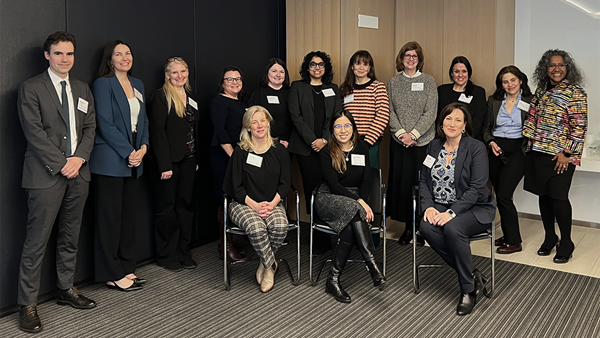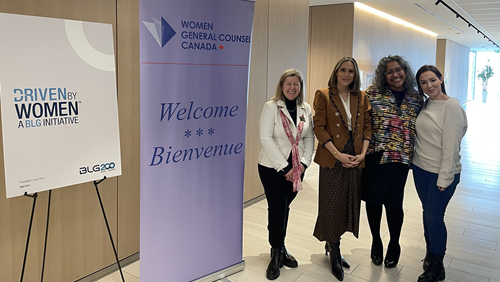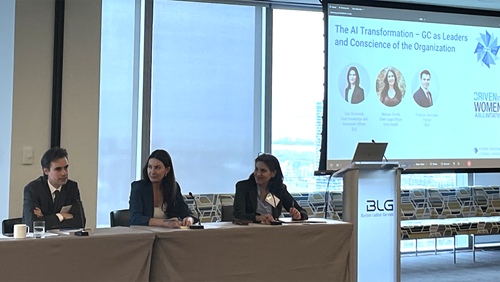What defines an inspiring leader? How do leaders set their vision, drive results and build successful pipelines?
These are the questions that surfaced when BLG hosted Women General Counsel Canada (WGCC) for a fulsome day of learning through their GCU Leadership program (GCU) on Jan. 26. Over 25 women from both public and private companies spanning many industries engaged with two panel discussions in an interactive conversation-style experience — sharing ideas, offering perspectives and conversing with peers.
WGCC’s GCU program is a leadership development program designed to elevate women general counsel (GCs), providing them with a curriculum that’s strategically mapped to the key competencies needed to perform at the highest levels and advance the business. The event was sponsored by BLG’s Driven By Women, an initiative that empowers women in business and law.

Panel one: Women leaders on driving innovation and delivering results
The day started with a panel moderated by BLG’s Cindy Clarke featuring Shelby Austin, chief executive officer at Arteria AI; Bindu Cudjoe, executive vice president, chief legal officer and corporate secretary at Laurentian Bank; and Sandra Perri, senior vice president and general counsel at Sun Life Canada. The women shared their unique paths to success while tackling three main themes that spoke to three of the GCU’s competencies of focus: engage and inspire; drive results; and cultivate innovation.
Here are some of the key takeaways from each theme.

Theme #1 – Engage and inspire: How can leaders build effective teams to execute lasting and meaningful change?
- Culture, culture, culture. As leaders, you play an active role in setting the right cultural tone at your organization. Shelby — who founded her first start-up over 15 years ago and has grown her most recent venture, Arteria AI, to 100 employees in three years — highlighted the importance of establishing a specific culture. Descriptors like “vision,” “friendliness,” “relentlessness”, and “radical accountability” were all used to describe her ideal work culture. A question for leaders: how would you want people to describe your team and the way it operates?
- Draw out a clear vision. Clear leadership was another key point of conversation. Bindu — who articled at BLG under the mentorship of panel moderator Cindy Clarke and now leads teams of many sizes — outlined just how important it is to make your values as a leader known and draw out a clear vision of where you want to go with the team. This starts from being openminded to what can bring people bring to the table, creating alignment with the vision, and leveraging the team’s strengths.
- Align your goals with the organization’s purpose. The goals and priorities of individuals and teams should always align with the overall goals and priorities of the organization. Sandra highlighted the importance of “refining decision-making frameworks and taking cues from the business.” Using the organization’s purpose as a guiding force is essential to setting your team up for success.
Theme #2 – Drive results: What is needed to achieve successful outcomes?
- The right people for the job. As Shelby says, it’s important to understand “who’s who at the zoo.” To identify the right players for the task requires understanding where each person within the organization fits and what they can bring to the table.
- Focus on what’s valuable to the organization. The panel agreed that results are rarely defined at the department level and often defined at the organizational level. As a result, Bindu says it doesn’t matter how awesome, smart or knowledgeable an individual is — or even a team. If the work produced isn’t relevant to the values of the organization or leadership, it’s likely not going to be seen as important.
- Doing the C job vs. the A job. Figuring out priorities and how much effort should go into a particular priority is a challenge, but one that can make a difference in achieving results. Sandra calls this “doing the C job vs. the A job.” The panel put it in simple terms: if a client is asking for a bicycle, you don’t always need to give them a sports car. And just as important as asking “What are we going to take on?” is asking “What are we going to take off?”
Theme #3 – Cultivate innovation: How can leaders make innovation happen?
- Identify your innovation end goal. “Innovation is not an end in itself,” says Shelby. “It’s a tool in your toolbox.” Here are some questions to ask when getting started:
- What does innovation mean to you?
- What is the goal?
- Where will innovation help me achieve this goal?
- Create an innovative culture. If innovation is an organizational goal, it should be embedded into every aspect of the organization. Innovation is a mindset, not one person’s responsibility. We can all seek to do things better, more efficiently or in a way that adds more value or generates better outcomes.
- Understand if innovation is worth the effort. Innovation can be a great tool but implementing innovation strategies and rolling out new tools can be expensive, time consuming and create a learning curve. When making decisions about innovation, consider whether the change is enough of a step change that we need innovation to get there.

Part 2: The AI transformation – General counsel as leaders and conscience of the organization
BLG’s chief knowledge and innovation officer, Lisa Chamandy, describes innovation as finding ways of “doing what we do – better, and doing things we’ve never done before”. Lisa moderated the second panel, an in-depth conversation about the AI transformation, alongside BLG partner, François Joli-Coeur, and Melanie de Wit, chief legal officer at Unity Health, who practiced in BLG’s Health Law group for six years before carving out a new path.
This panel covered several important topics on the AI transformation across industries. Here are the key takeaways.
New risks
AI has been a hot topic in technology and privacy spaces for a while now, but with the use of large language models and other tools creeping into a variety of other industries, leaders have noticed new risks that need to be monitored. One of the main concerns is the use of generative AI by employees. With tools like ChatGPT at our fingertips, leaders have growing concerns about the use of AI outside of a company’s system. As a reaction, the “low hanging fruit” to combat this fear, says François, is to implement a policy about the use of these tools.
In addition, according to our panel, copyright, bias outcomes and AI governance are also top of mind for leaders when it comes to risks of the AI boom.
Approaches to risk management
Since it’s inevitable that GCs will have to face the ongoing challenges that come from technology transformations, what are some of the approaches to risk management?
Melanie outlined some important ways to manage risk by establishing baseline standards for risk tolerance. Firstly, organizations may find it beneficial to compartmentalize the risks into risk categories to assess activities of a similar nature. For example, categories may include regulatory risks, financial risks and people risks. This allows for a comprehensive look at all potential risks and where they may emerge.
The second approach is to create risk register documents, which can identify potential risks before they become true problems. Some ways to identify and analyze potential risks include literature reviews, identifying patterns, finding subtypes of risks and measuring risk velocity, which affects how much time you’ll have to mitigate the risk once it’s already happening.
Women General Counsel Canada’s GCU event was the perfect blend of inspiration and information, drawing together real-world experience and practical recommendations from some of Canada’s top legal leaders. If you are a GC or leader at your organization with additional questions about making innovation happen, driving results or how to mitigate the risks of the AI transformation, please reach out to any of the authors or key contacts below. We also invite you to learn more about Driven By Women.



